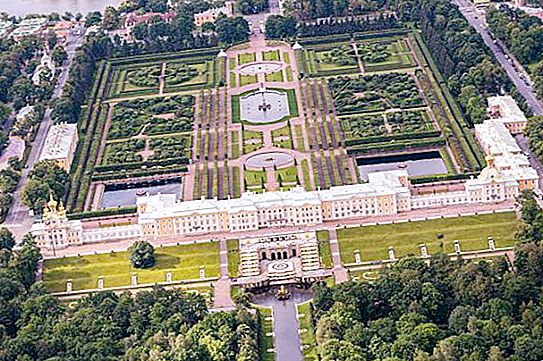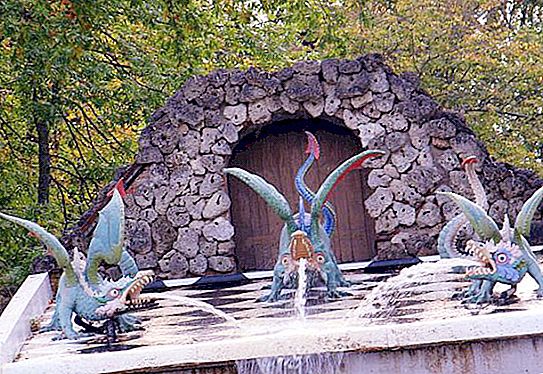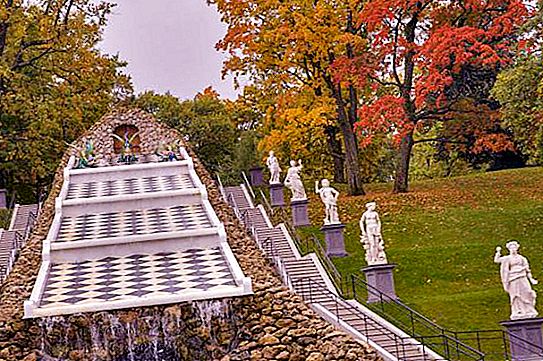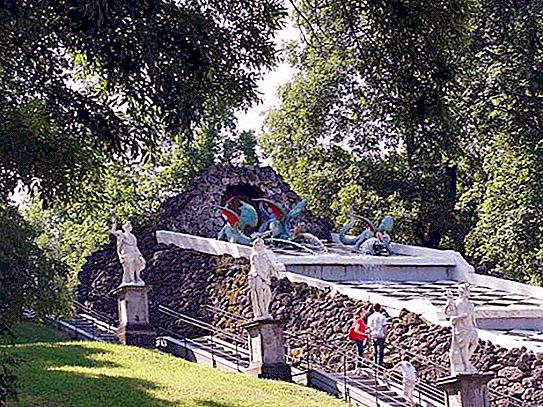The Chess Mountain cascade is equipped on the natural slope of the Lower Park of the Peterhof Museum-Reserve, in the eastern part of the park complex.

This complex is also called the "Dragon Cascade" or "Ruin Cascade." It got its name thanks to the drain slopes, painted with white and black paints in the form of a chessboard. What is the story of this unique element of the Peterhof Palace and Park Ensemble? Who is the author of the Chess Mountain cascade? What interesting facts are known about the fountain composition?
Description of cascading composition
The composition "Chess Mountain" includes Lower and Upper Grottoes and four rectangular slopes covered with a thin layer of water. The water surface resembles huge mirrors, in which glare of light plays beautifully in sunny, clear weather.
A massive door leads to the Upper Grotto of "Chess Mountain", which is closed. It is guarded by three formidable dragons, from the mouths of which water escapes, flowing down the cascading slope and after 32 meters falling into the round bowl of the pool. Her water forms a canopy, which covers the entrance to the Lower Grotto.

On both sides of the Chess Mountain, there are two stairs that adorn the white marble sculptures brought in 1724 from Italy: Flora, Olympia, the Priestess, Neptune, Jupiter, Volcano, Tsecera, Adonis, Pluto and Flora. These 10 sculptures are a valuable collection of the Peterhof Museum Reserve and were created by Italian sculptors in the 18th century.

The creators of a unique fountain complex
The construction and design of Peterhof’s Chess Mountain was attended by architects M. Zemtsov, I. Blank, I. Braunstein, I. Davydov, the Barattini brothers, T. Usov. The cascade was originally conceived by Peter I as the “Ruin”, it was supposed to look like a ruined fortress tower, symbolizing the capture of Swedish fortifications by Russians.
The architects N. Miketti, J. Felten, J.-B. also worked on the cascade project. Leblon, N. Benoit.
The water supply to the Chess Mountain fountain was laid by the famous master Vasily Tuvolkov.
The history of the cascade complex
The construction of the fountain cascade began under Peter Ι in 1721. In place of the small grotto, built in 1717, the emperor ordered the construction of the Marble Fountain Cascade, which was supposed to be similar to the Small Cascade in Marly, the residence of the French kings.
According to the drawings of Nikola Miketti, work began. At the top of the cascade was the composition "Neptune Cart" with four horses, from the mouths of which streams of water would erupt. On both sides of the fountain, they also wanted to establish dilapidated fortresses. Such a composition was conceived by Peter Ι, but his plans during life were not destined to come true.
Due to lack of materials, the Marble Cascade was never built. Work in 1727 was suspended. And the Neptune Cart, cast by architect Rastrelli, was placed in the Upper Park.
Ten years later, construction was resumed, but on a new project, which was developed by Mikhail Zemtsov. The fountain cascade was decorated with wooden dragons, from the mouths of which water erupted and flowed down a plateau lined with lead. Since that time, the cascade was called "Dragon".
On both sides of the fountain complex, marble sculptures of Italian masters of the 18th century were installed.

In 1769, the drain plateau was painted with white and black squares, because of which the cascade complex was called "Chess Mountain".
A hundred years later, in 1875, wooden dragons were replaced by metal ones.
The fate of the fountain complex "Chess Mountain" during the Great Patriotic War
During the war years in 1941, all marble sculptures were removed and buried deep in the ground to preserve historical exhibits. As a result of the bombing of German-fascist forces, the Chess Mountain Peterhof suffered greatly. After the war in 1953, the cascade during restoration work was completely restored according to the sketches of the 18th century. The statues were safely removed from the earth and returned to their former places.
Interesting facts about cascading composition
In 1875, an eagle sculpture was installed on the wall of the Upper Grotto, and sculptures of Nymphs and Satires created by St. Petersburg architect Peter Stavasser were installed in the pool. These new marble figures did not fit into the general composition of the Chess Mountain fountain, but still stood there until 1941.
During the war period, the statues of the eagle, Nymph, Satire and dragons were abducted by the Nazis. The workers of the park managed to bury the remaining marble sculptures in the ground, and their German invaders did not find them. In 1953, all of them were excavated, while during the war, none of the ten sculptures were seriously injured. Thus, the museum staff managed to preserve the historical heritage of Peter's times.




